
125 for the 125th
The extraordinary people, the surprising stories,
and the irrepressible spirit that make North Park University worth celebrating
September 7, 2016
In 1901, a decade after the founding of North Park, President David Nyvall gave a speech in which he spoke of his desire “to see this our beloved school the university of the world, to hear in these halls the echo of applause from every quarter of the globe for thoughts nobly thought, for words nobly spoken, and for arts nobly executed.” He dreamed aloud that North Park would be “a center from which radiates to all ends of the world the light of Christ’s truth, the warmth of Christ’s love, and the beauty of Christ’s character.” He concluded: “This, my friends, would be, in my estimation, a school not only up-to-date but up to eternity, a school with a schedule for becoming a Christian university.”
More than a century later, we see Nyvall’s prophetic dream realized in a university that is both “up-to-date” and “up to eternity.” As the college and seminary of the Evangelical Covenant Church, North Park’s influence continues to shape our leaders, churches, families, and communities. Here, in honor of the school’s 125th anniversary, the Companion shares 125 reasons to celebrate North Park.
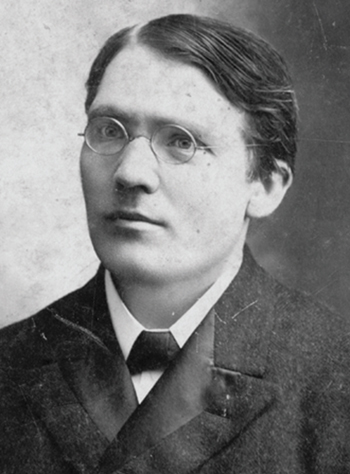
David Nyvall the first president of NPU
1
North Park was founded in 1891 by the Covenant Church when delegates to the Annual Meeting unanimously accepted E. A. Skogsbergh’s recommendation to turn his Minneapolis school into the denomination’s college and seminary. David Nyvall was named president and sole faculty member of the seminary.
2
North Park’s motto comes from Psalm 36:9: “In thy light shall we see light.”
3
North Park opened in the basement of the Swedish Tabernacle Church in Minneapolis under the name, the Swedish Evangelical Mission Covenant College. The school moved from Minneapolis to Chicago in 1894.
4
In 1894 when students first arrived at the Chicago campus, it was still a community of small farms, and to the north, one very large nursery. The school’s first address was Station X.
5
When offered property to relocate to suburban Grayslake in 1980, the school rejected the proposal, choosing to stay in the city.
6 –Purposeful Design
When we think about architecture, we usually think about structures we design and construct. That kind of architecture is important to a college campus, but I’m more inclined to think about our landscape architecture to depict the character of North Park.
No Perimeter
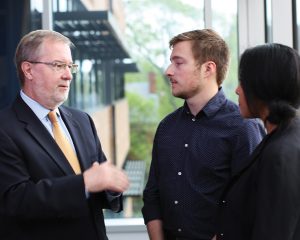
President David L. Parkyn, Blake Thomas, Carmen Velazquez-Alvarez
Imagine two NPU students who want to get together text each other saying, “Meet me at 1:30 today on the edge of campus,” or, “Meet me at the east gate of campus.” Those two students would never get together. Because on our campus we haven’t clearly defined the north perimeter or the east side of campus. It just doesn’t work that way—the boundaries to our campus community are not clearly defined. In fact, if you brought 100 students together and asked them to draw a map of North Park, there would be some similarities from one map to the next, but I can guarantee that the boundaries of the campus—its perimeter—would be distinct from one student to the next. No two of them would identify it in quite the same way.
A Clear Center
Now if those two students had said, “Meet me at 1:30 today at the center of campus,” they would have been sure to meet. Because while our landscape architecture purposefully has not defined the edges of our campus, it has very clearly defined the center. This location is not geographically centered on the campus, but it’s at a point where significant crossroads intercept each other. Our landscape architects have installed the seal of the university in the walkway, and around that seal a compass, and around all of that a low ledge with four passages from Scripture inscribed on it. It’s a place where people meet and it’s a place that defines the heart of campus.
Our Mission
Those two images characterize a lot about North Park. No boundary, no edge, no perimeter—but a very clearly defined, located, and described center. Our mission is to prepare students for lives of significance and service. That significance and this service is informed by the center, but it doesn’t happen at the center. North Park is an educational community that draws students in and then sends them out. We do that, not by defining the edges or saying, “Enter through that gate and then stay within this fence,” but through a type of magnetic force—one that draws in to shape and mold and then sends out to serve, as we say, for God’s glory, and neighbor’s good.
Education for significance and service happens as our students come to campus and then leave—still connected to the center, but always headed outward, always focused on something beyond the campus.

7 –Carmen Velazquez-Alvarez class of 2016
When Carmen Velazquez-Alvarez was eleven years old, her family fled the violence of her native Veracruz, Mexico, and escaped to the United States. When they arrived in the U.S. they had little food and no access to medical care, and Carmen was homeless for several months. Eventually they made their way to California’s Central Valley, where they did field work together. They attended Kerman Covenant Church, and Carmen began dreaming of attending North Park.
A Natural Leader
“When I first visited North Park, it was late March,” she says. “The flowers were not blooming yet and the campus was still showing the results of the harsh winter. Despite that, North Park seemed so lively! People were very inviting, professors were amazing and super welcoming and embracing. I fell in love with the mission and vision of North Park University immediately.”
I fell in love with the mission and vision of North Park University immediately.
Last spring Carmen graduated with a degree in conflict transformation studies and a certificate in nonprofit management. She was a leader on campus, serving as president of NPU’s Latin American Student Organization, and she co-founded the Latinas Unidas Mentorship Program, established to prepare her fellow Latina students for success. She was also active as a Faith and Justice Team student leader. For her leadership, service, and scholarship, she received the Distinguished Senior Award.
Giving Back
There are kids who came from Central America or Mexico, and they don’t get to go to school,” Carmen says. “So I didn’t go to school just for me. It’s for God, and for my family and the people I work with. I know there are serious circumstances that keep them from going to school, but how can my education help them in the future? How can I go back to the valley and help my people?”
Empowered
At NPU she says she discovered how to serve God and follow God in a personal way.
North Park challenged my faith, my identity, my insecurities, my view of life. I was able to discover more about my identity and be strengthened by that. I was able to see the challenges in life as obstacles I was empowered to overcome.
Currently she is working as library clerk/student worker supervisor at West Hills Community College in Coalinga, California. In that role she develops workshops and projects to enhance and promote higher education success for first-generation students. She also mentors low-income underserved children and leads water and food drives for the homeless community.
8
or the first time, this fall Wednesday afternoon classes are being held throughout the city rather than on campus. Students may observe a courtroom downtown, learn from alumni at their places of employment, study the diversity of Chicago neighborhoods, talk with police at the police headquarters, or draw water samples from Lake Michigan to track changes in water quality.
9
“Economic and demographic changes in recent years mean that young people are flocking to cities, to live and work in urban areas. I believe universities located in urban areas will be at a distinct advantage going forward. At the same time, given that the majority of babies born in the U.S. from now on are majority minority, universities must be able to attract a diversity of students. North Park shines at this, both due to its location and its deep commitments.” —Michael Emerson, provost
10
This fall NPU launched a new Urban Living–Learning Discipleship Community where students live together in community with discipleship coaches, take classes together, engage in guided prayer and Bible study, and serve in the city.
11
Each week faculty and staff read with children at Hibbard Elementary School, where more than forty languages are spoken by students and their families.
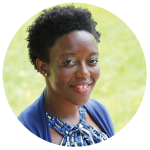
12
“It is such an asset to be in the city. The school has set in motion some really great partnerships in and around Chicago. What a gift to be right in the heart of an urban setting. Community engagement is an area that the school can grow in. I’m excited to see what the school will do with that. We could transform the community.” —Elizabeth Pierre, pastoral care and counseling teaching fellow
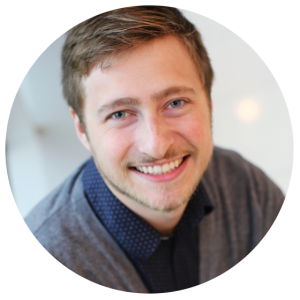
13 –Blake Thomas
Class of 2016
Last spring Blake Thomas graduated from North Park with a double major in youth ministry and biblical and theological studies—and was honored with the Distinguished Senior Award in recognition of his leadership, service, and scholarship.
He came to North Park from Olathe, Kansas, where his family attends Prairie Village Covenant Church. “After growing up in the suburbs of Kansas, I was looking for a change of scenery and pace,” he says. “I also knew that I wanted to go to a Christian school and North Park is distinct in that way. They have professors of diverse Christian thought who provide students a well-rounded perspective on theology. I knew that other schools could not offer that same experience.”
He says his education changed him. “Being in Chicago shaped the way I think about issues like race and poverty and where we are headed.” He learned to sort out what he believed and why, to become a critical thinker. “When you combine commuters from the South Side with Native Alaskans, international students from Sweden, and all kinds of students in between, you’re going to find a large array of thought. North Park fosters that in a great way that encourages students to feed off and learn from each other.”
Being in Chicago shaped the way I think about issues like race and poverty and where we are headed.
He currently serves as youth pastor at North Park Covenant Church in Chicago, and plans to pursue a master of divinity degree.
Athletic Highs and Lows
14 –Five-Time NCAA Champs
North Park has won five national championships in men’s basketball—the most wins of any university in NCAA Division III and any college or university at any NCAA level in Illinois.
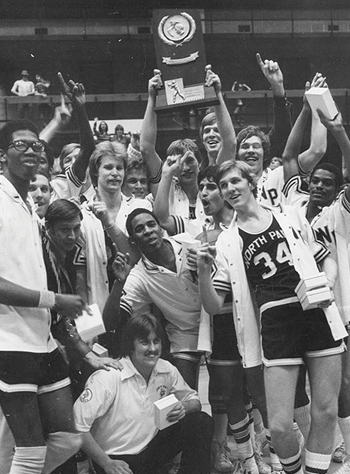
The Mens North Park Basketball team after winning the championship
15
The first North Park College football game was played in 1899.
16
In 1929 NPU replaced women varsity sports with intramurals because intercollegiate competition was deemed unladylike.
17
Today there are eight women’s varsity sports, and only seven for men.
18
In 1949 the North Park Academy football team finished with a perfect record of 8-0. The 1950 team went on to be undefeated as well. The Academy basketball team also had a perfect record of 25-0 in 1949. It was a great year for sports!
19
On October 12, 1968, North Park’s football team defeated North Central by a score of 104 to 32. The game set a number of NCAA records, nine of which still stand today. Most of those are held by Bruce Swanson, Paul Zaeske, and Art Anderson.
20
In May 1971 faculty voted on whether a male athlete who had broken the rules could play. The infraction was long hair—it fell below the base of his neck. By a vote of 37 to 31—and one abstention—faculty decided the offending athlete had to stay on the sidelines.
21
The Holmgren Athletic Complex, dedicated in 2003, was named for Covenanter Mike Holmgren, former coach of the Seattle Seahawks and the Green Bay Packers.
22
In 2004 during their first season of varsity crew competition, the women’s rowing team won a gold medal at the Dad Vail Regatta in Philadelphia—the largest college rowing event in the U.S. They finished ahead of Purdue University by four seconds in the Women’s Novice 4+ race.
23
The men’s soccer team has won four CCIW championships and six NCAA tournaments since 2004.
24
When Edward Sternaman, co-owner and co-head coach of the Chicago Bears, suffered significant financial losses during the Great Depression, he sold his share of the team to George “Papa Bear” Halas—and then went on to coach North Park’s football team in 1930s. He was added to the Bears Ring of Honor in 2009.
Under the Microscope
25 –The Johnson Center
“Frankly there are many colleges that can offer a good science education. What North Park offers in addition is a true urban educational experience in a faith-based environment. We think that combination is hard to beat.”—G. Timothy and Nancy Johnson, upon the dedication of the new science center in the fall of 2014
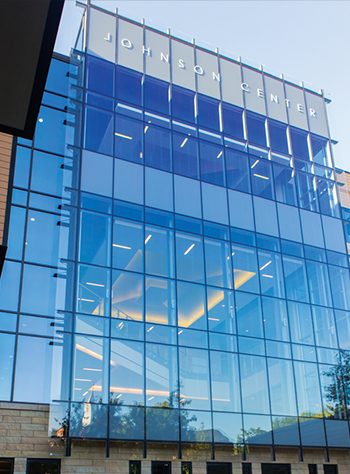
26
The three-story 101,000-square-foot Nancy and G. Timothy Johnson Center for Science and Community Life, completed in 2014, contains a nuclear magnetic resonance (NMR) machine used to determine molecular structure, which is rare for a school of North Park’s size.
27
One of the exciting features of the Johnson Center is the new state-of-the-art cadaver lab.
28
The nursing program began in 1965, and the first class of nine students graduated in 1968.
29
Nursing is now one of the top three majors of the school. In the 2015-2016 academic year, eighty students graduated from the program, forty-eight graduated with master’s degrees, and two completed post-master’s certificates.
A World of Impact

Abernathy Children on front line leading the Selma to Montgomery March for the right to vote
30 –Marching for Justice in Selma
Six members of the college and seminary faculty participated in the 1965 march from Selma to Montgomery led by Martin Luther King Jr.—Cal Katter, Mel Soneson, Vern Wettersten, Fred Holmgren, Elder Lindahl, and Earl Dahlstrom.
31
In 2000 students participated in the first NPU Sankofa trip, traveling to civil rights landmarks throughout the South.
32
Global partnership trips to such places as India, Appalachia, Honduras, Zambia, South Africa, and Mexico are offered during spring and summer breaks where students learn, build relationships, and serve.
33
Twenty-seven percent of recent graduates spent time learning or serving abroad in fifty-four different countries.
34
In June NPU was one of sixty-seven colleges and universities selected to participate in the U.S. Department of Education’s Second Chance Pell program. The pilot program will allow eligible incarcerated students to receive Pell Grants and pursue post-secondary education, enrolling 12,000 prisoners at more than 100 correctional institutions around the country.
Swedish Roots
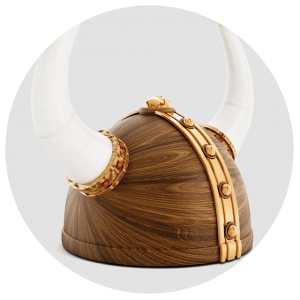
35
In 1976 a student exchange program began between North Park and Södra Vätterbygdens Folkhögskola (SVF) in Jönköping, Sweden. The program celebrated its fortieth anniversary this year, making it the longest continuous exchange program between Sweden and the United States.
36
King Carl Gustaf and Queen Silvia of Sweden made a royal visit to NPU in 1982 to take part in the dedication of the Hugo Anderson Chair in Scandinavian Studies. Anderson, who as a banker with First National Bank of Chicago had helped the oil industry survive the Great Depression, served for many years as chair of North Park’s board of directors. He also endowed the seminary’s Nils W. Lund Lectureship.
37
North Park’s mascot is the Vikings and the school colors are blue and gold.
38
The developers—the Swedish University Association—who gave the Covenant Church 8.5 acres to build North Park College in Chicago, envisioned creating a Covenant community in the surrounding area. They advertised lots for sale in Covenant newspapers; however, they fell far short of the 700 they hoped to sell, and the building boom didn’t reach North Park until a few decades later.
39
A bronze statue of Swedish hymn writer Lina Sandell (1832-1903) sits in front of Nyvall Hall. The original, by artist Axel Wallenberg, is in the Fröderyd Church in Småland, Sweden.
40
Tre Kroner, a Swedish restaurant across Foster from North Park, opened in 1992 and was featured on Guy Fieri’s Diners, Drive-ins, and Dives in 2009. On display in the restaurant are two jerseys from the Stanley Cup-winning Blackhawks, Swedish players Niklas Hjalmarsson and Marcus Krüger.
Why North Park?
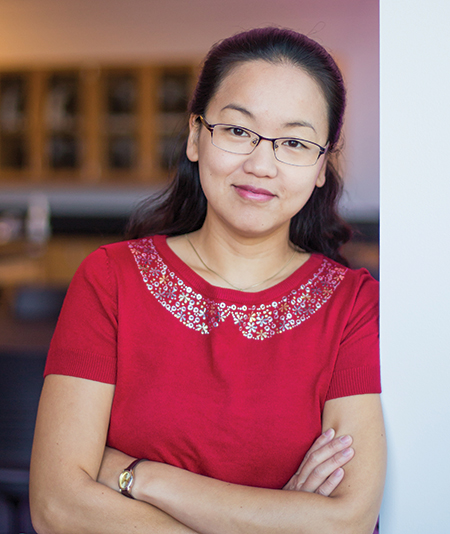
Yoojin Choi, associate professor of biology
41
“Reasons I teach at North Park: it is the constant love and support from the North Park community that keeps me wholly grounded; it is the real sense of comfort I get knowing that I can exercise my faith, academic, and creative practices freely without inhibition; it is North Park’s ability to embrace people of diverse backgrounds. Most important, it is the ‘feel-at-home’ factor that nurtures my desire to shape and make a difference in the lives of our students and the community.” —Nnenna Okore, professor of art
42
“I joined North Park faculty primarily due to the school’s location and alignment of duties with my experience, but I stay because I like the people here. I have Christian colleagues who are good at what they do and good to the people around them. Everyone I interact with regularly cares deeply for the students.” —Yoojin Choi, associate professor of biology
Musical Notes
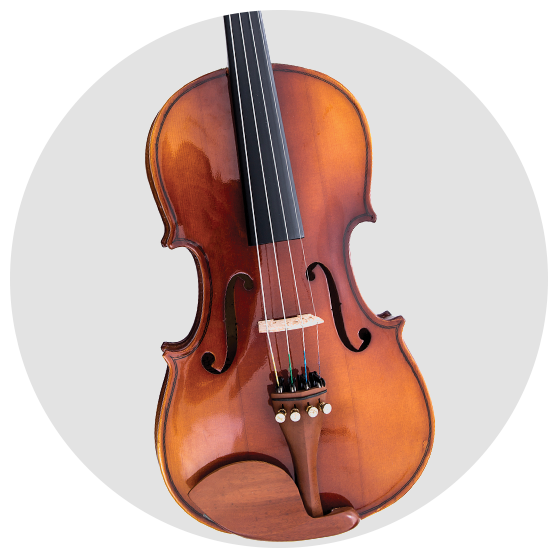
43
North Park started a brass band in 1901. Members paid two cents per hour to rent instruments.
44
The men’s and women’s glee clubs combined to form the College Choir in 1938.
45
The college added a marching band in 1964 that played the halftime shows of home football games.
46
From 1947 to 2001, the College Choir performed annually at Chicago’s Symphony Hall. Traditionally each concert concluded with Lina Sandell’s hymn “Tryggare Kan Ingen Vara” (“Children of the Heavenly Father”).
47
The Gospel Choir began in 1993 as a student-led group with fifteen students. By the end of the year they had thirty-five members, and last spring there were eighty-four members.
48- Rare & Wonderful Community
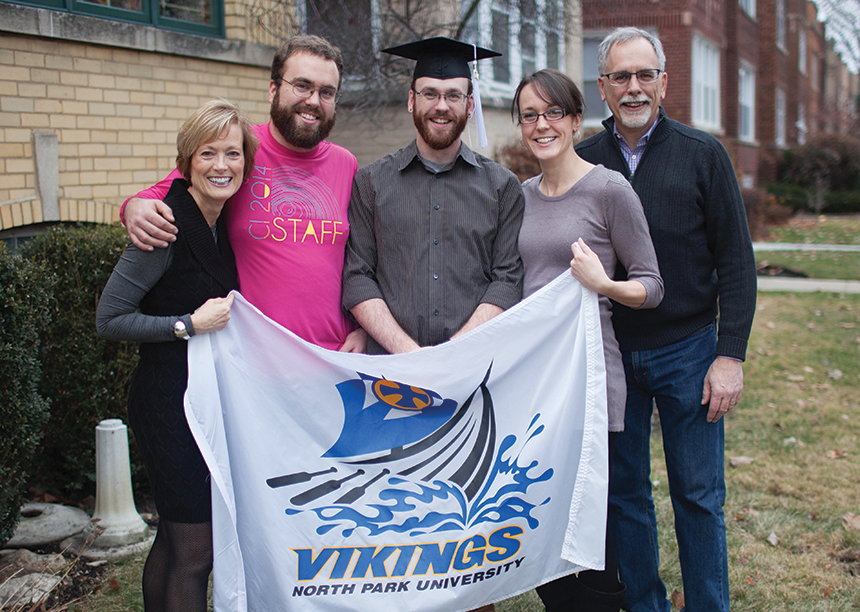
Pictured: Beth Fredrickson, member of North Park Board of Trustees, and her family, all NPU alums
I came to North Park as something of a nomad. My family moved every two or three years when my dad, a U.S. Army chaplain, got a new assignment. My dad was a Covenant chaplain, though, so even though I knew very little about it, North Park was a given.
I quickly discovered that North Park was a place where relationships—many with connections to the Covenant Church—created a place to belong. Learning within that context made my heart sing. I loved the academic community, the opportunities to intensely explore Christian faith, the tapestry of people, the city of Chicago, and the extraordinary relationships that revealed me to myself, and more importantly, influenced me for Christ. I immersed myself in campus life, both inside and outside the classroom. The experience formed me for the future God had in mind.
As was true for my husband and our three children, all of whom are North Park graduates, North Park was fundamentally a formative place of Christian community and authentic faith development, and a launching pad for rich, lifelong friendships.
A big piece of the future North Park opened to me was relationship with the larger Covenant family. Those connections have significantly shaped my professional life, my opportunities as a lay leader, and my walk as a follower of Jesus.
Forming Leaders
I see North Park as the primary incubator for developing lay leadership, faith formation in the Covenant tradition, ministerial development, and biblical and theological training and direction-setting for the ECC. As the university is biblically centered and focused on the development of minds, hearts, and hands that are attuned to kingdom purposes, the whole of the church is better equipped.
As a member of North Park’s board, I am particularly interested in the relationship between North Park and the ECC. That intrigues and excites me. I believe God wants to use North Park to help grow and form the church, making it ever more prepared and ready to serve a hurting, confused world, and more eager to draw people to Christ.
On a global level, I believe North Park can stand out as a premier Christian university with a particular Covenant flavor. I am intrigued by the discussion we might have around that idea. What does it mean for North Park to be part of the ECC? How might students and faculty benefit from what the ECC has to offer? How can North Park form closer relationships with diverse Covenant congregations and ministries?
Powerful Relationships
I hope North Park will always be a place of rare, wonderful community for anyone who encounters it—both the people who inhabit it in real time, and those who carry it with us in our spirits. Those relationships transcend many differences, enhance the learning experience, feed and energize faith, and lay a foundation for a life of meaning and service.
Maintaining and growing this unique community is a challenge in an age of increased online learning, student preferences for apartments instead of dorms, a broader age range of students with the expansion of graduate and adult learning programs, and larger numbers of students who do not live on campus. I trust the board, leadership team, and campus community to address this challenge creatively, and to look for new opportunities to enhance what I believe is a distinguishing characteristic of North Park.
49- Is North Park’s Original Vision Still Viable?
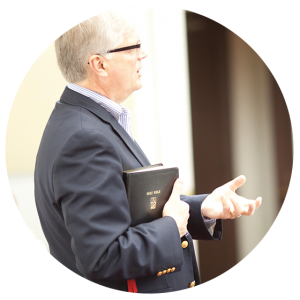
John E. Phelan Jr., senior professor of theological studies at the seminary
“Of all the departments of North Park College and Theological Seminary,” writes Leland Carlson in his History of North Park College, “the Theological Seminary has the unique distinction of continuous existence from 1891 to the present day. The reasons for this fact,” he continues, “is that when the founders made plans for a Covenant school they thought primarily of an institution which would train ministers for the denomination.”
The Dream
For some in the Swedish community that original purpose was enough. They wanted the school to be a simple Bible school for preachers. They weren’t particularly interested in developing programs for the liberal arts, even worrying that such a program would bring “worldly influences” in its wake that would undermine the faith of its young charges.
When the founders made plans for a Covenant school they thought primarily of an institution which would train ministers for the denomination.
But North Park’s brilliant young president, David Nyvall, thought otherwise. Writing in 1895 after the school moved to Chicago from Minneapolis, Nyvall argued (long before women were ordained as pastors), “A preacher needs to be a man also educated in the liberal arts. He should not be educated into a separate caste and thus through his education be destined to live in a world totally alien to the life interests of the common people.” Ministers of the gospel, Nyvall argued, needed to be grounded not only in Scripture, theology, history, and ministerial practices, but also in literature, science, art, and music, among other things. This concern reflected Nyvall’s greater vision: to establish a full-orbed university. While the education of men and women for ministry would remain a central and abiding concern, Nyvall dreamed of more for his fledgling school, and for the Covenant Church.
First steps
North Park began its work in Chicago with three departments or programs: the Academy (a high-school program), the commercial department (a business program), and the seminary. After a failed attempt to establish a liberal arts college in 1902, North Park successfully launched a junior college program in 1919. That school expanded to include a full four-year liberals arts college in 1958 and became a nationally recognized university in 1997, which now, in addition to a rich selection of undergraduate majors, offers numerous graduate degrees.
Those early teachers in the basement of First Covenant Church in Minneapolis would scarcely recognize the school today. But with all its accomplishments, at the school’s 125th birthday it is fair to ask whether David Nyvall’s dream has been realized.
A City School
North Park’s website declares it is “Christian, urban, and intercultural.” Its Christian mission continues to be primary. Some things are obviously different: a faculty, staff, and student body made up of immigrant Swedes drawn from the Evangelical Covenant Church and other small immigrant churches has given way to faculty, staff, and students drawn from scores of Christian denominations, and in the case of the students, many world religions. North Park stresses not only its Christian and intercultural character but also its urban setting. The school’s first buildings were constructed in a bucolic setting far from the center of the city. Today it is fully integrated into one of the world’s great urban centers. The school has consistently sought to make the city an integral part of its curriculum. Whether it is students tutoring at a local school or seminarians studying theology in a prison, North Park intends for all of its students to be prepared for “a life of significance and service.”
Purposeful
How, then, does North Park fit with the emerging mission and vision of the Evangelical Covenant Church? The seminary, of course, continues in its 125-year role of preparing pastors and teachers, scholars and chaplains, missionaries and administrators. But that’s not all. The Covenant Church shares the wider university’s mission to live out the call of the gospel within the growing cultural diversity of the United States and Canada, not to mention through its mission work throughout the world.
Those of us who teach at North Park hope our students will be successful and even prosperous. We hope they find good jobs and rewarding careers. But we share with David Nyvall that original vision that they will also be committed to serving the “life interests of common people” through their service on behalf of God’s kingdom.
Whether they are teachers in an urban high school, nurses in a rural clinic, pastors in suburban churches, or entrepreneurs providing jobs around the world, our goal for them is to address the needs and challenges of all people, common and uncommon and beloved of God.
Academic Pursuits

50
Currently NPU has 113 full-time faculty members.
51
Lena (Caroline) Sahlstrom was the first woman on the faculty, the first dean of women, and the first person for whom a building was named.
52
In 1975 Frances Anderson became the first full-time female faculty member at the seminary.
53
The precursor to the School of Business offered a class in penmanship.
54
Ninety percent of current full-time faculty hold a PhD in their field.
55
In 1942 dean of the seminary Nils Lund published Chiasmus in the New Testament, which became a definitive text on biblical structure still referenced today.
56
In 2007 the first class of seventeen students graduated from the Center for Spiritual Direction. Four years later the center was renamed the C. John Weborg Center for Spiritual Direction in honor of the long-time seminary professor and Covenant Companion columnist.
57
The U.S. Fulbright Program has awarded grants to nineteen students and three faculty members in the past eight years.
58
F. Burton Nelson, who taught ethics and theology at the seminary from 1960 to 2004, was a renowned Bonhoeffer scholar. His daughter Rebecca Nelson is currently the dean of the School of Education.
59
The Axelson Center for Nonprofit Management was dedicated in January 2000. It was named in honor of Nils Axelson, who served for forty years as president of Covenant Benevolent Institutions.
60
Provost Michael Emerson is author of Divided by Faith: Evangelical Religion and the Problem of Race in America, the 2001 seminal book on race and faith.
61
Stories with Intent: A Comprehensive Guide to the Parables of Jesus by seminary professor Klyne Snodgrass, was named 2009’s “Best Book in Biblical Studies” by Christianity Today.
62
Soong-Chan Rah, seminary professor and author of The Next Evangelicalism, helped launch a DMin in urban ministry leadership in 2013.
A Changing Campus
63
North Park began its work in Chicago with three departments or programs: the seminary, the Academy (a high-school program), and the commercial department (a business program). A music department was added in 1895.
64
In 1912 English replaced Swedish as the primary language of instruction in the seminary.
65
North Park’s two-year junior college program started in 1919. In 1956 the first class of four-year students was admitted.
66
The end of WWII and the G.I. Bill brought many older Covenant students to the college and seminary.
67
The final Academy class graduated in 1969.
68
When North Park Academy—a secondary school—closed in 1969, the school made plans to tear down Wilson Hall, which along with Old Main had housed the academy. The director of development announced that Wilson was structurally unsound. Students and faculty protested, occupied offices in the building, and brought in a structural engineer who found the building structurally sound. The demolition plans were scrapped. Today Wilson houses the art department.
69
In 1997, North Park College became North Park University.
70
The U.S. Army Corps of Engineers collaborated in 2009 with NPU to reinforce the banks of Chicago’s North Branch River that runs through campus.
71
As of 2012 NPU had planted an average of eighteen trees a year during each of the past eighteen years.
72
Faculty, students, and neighbors protested the removal of the mulberry tree in the center of campus for the construction of the Johnson Center. Wood from the tree was used to build a cross and bench in a prayer room which is located on the former site of the tree.
73
Today students occupy only three dorms on campus: Anderson, Burgh, and Ohlson. Many students live in the university’s 246 apartments and student houses.
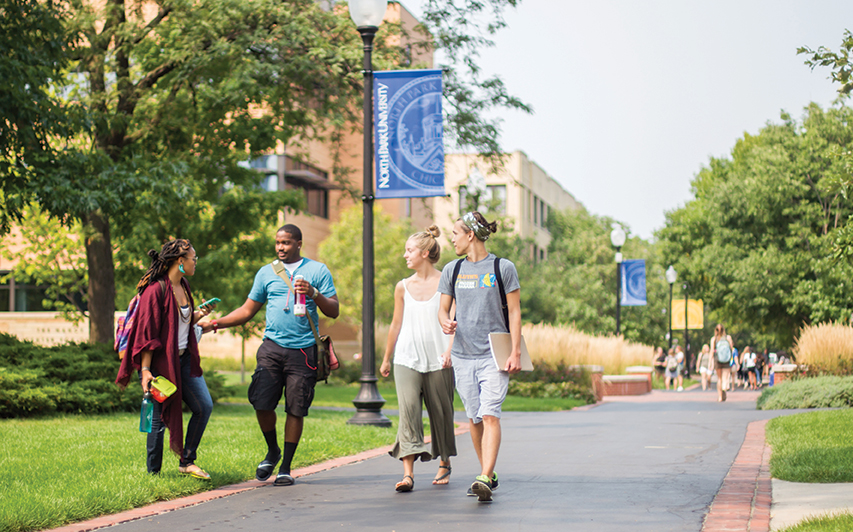
North Park by the Numbers
74
Enrollment increased from just under 500 to nearly 2,000 students in the 1930s—the majority of whom were non-Covenant Chicago commuters—thanks to NPU’s low tuition and the closing of Chicago city colleges.
75
Transfer students make up 33 percent of the student body.
76
The average class size is eighteen.
77
The current faculty to student ratio is 11 to 1.
78
With an enrollment of 3,200 students, North Park undergraduates represent forty-two states and thirty-four different countries.
79
In 2012 undergrad women outnumbered men 3 to 2.
80
The North Park campus has grown from 8.5 acres to thirty-one acres.
81
Of the fifty-nine buildings owned by NPU, forty-six are on campus.
82
There are seven schools within the university: College of Arts and Sciences, Schools of Nursing and Health Sciences, Music, Education, Professional Studies, North Park Theological Seminary, and School of Business and Nonprofit Management.
Guess Who Went to NPU?
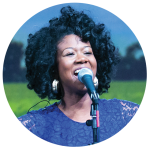
Sharon Irving
83
Graduates of the Academy include former Illinois governor Jim Thompson (C 1953).
84
Sharon Irving (C 2008) made it to the semi-finals in the tenth season of America’s Got Talent in 2015.
85
Pete Tamte (C 1989) directed Bunjie’s marketing efforts during the unveiling of Halo and went on to guide the sale of Halo to Microsoft. He was also part of Apple’s senior marketing team (reporting directly to Steve Jobs) when Apple announced its original iMac and iBook.

G. Timothy and Nancy Johnson
86
G. Timothy Johnson (C 1956, S 1963) was medical editor of ABC News for more than three decades.
87
Paul J. Marwin served in the Minnesota House of Representatives from 1915 to 1919.
88
In 2010 Nancy Faust (C 1969) retired as organist for the Chicago White Sox after forty-one years. She and Harry Caray started the seventh-inning stretch tradition of singing “Take Me Out to the Ball Game.” She was also the first to play Steam’s “Na Na Hey Hey Kiss Him Goodbye” when a pitcher is pulled from a game.
89
Marvin V. Curtis (C 1972) was the first African American composer commissioned to write a choral work for a presidential inauguration. “The City on the Hill” premiered at Bill Clinton’s 1993 inauguration. He also composed a work for North Park’s 125th anniversary celebration.
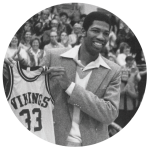
Michael Harper
90
Michael Harper (C 1980), who took the Vikings to three consecutive Division III national championships (1978-1980) as a student, was the first North Parker to be drafted into the NBA. He was a third round pick for the Portland Trailblazers.
91
American music critic Raymond Ericson (C 1934) wrote for the New York Times for thirty years until he retired in 1981.
92
Chuck Burgoon was selected in the third round of the NFL draft by the Minnesota Vikings in 1970.
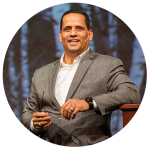
Wilfredo De Jesús
93
Wilfredo De Jesús (S 2006), known as Pastor Choco, was featured in two Time magazine cover stories in 2013. The first was “The Rise of Evangelicós,” followed by Time’s 100 most influential people in the world for his work in Chicago’s Humboldt Park community and his leadership among Hispanic Christians throughout the country.
Old Main
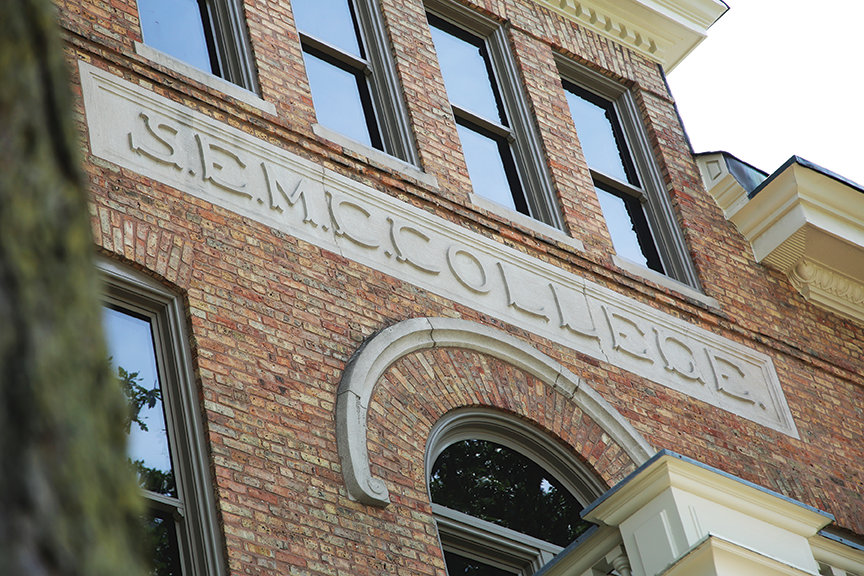
94
A full-length musical, Old Main: A Love Story, was written by Rick Carlson and Bob Stromberg to celebrate NPU’s 100th anniversary.
95
The cupola atop Old Main was illuminated for the first time with electric lights in 1926 and served as a beacon for pilots flying over the area on their way to Orchard Field (now O’Hare International Airport). It was the tallest point on the city’s North Side.
96
On September 26, 1893, the cornerstone of Old Main was placed, including a box containing a Bible, two songbooks, the latest catalogue of the school, the Covenant’s yearbook, copies of several Swedish and American newspapers, coin samples, and pictures of denominational leaders C. A. Björk, David Nyvall, and E. A. Skogsbergh.
97
Above the front porch is inscribed: SEMC COLLEGE, which stands for Swedish Evangelical Mission Covenant College, North Park’s original name.
98
Old Main was designated a U.S. landmark and entered in the National Register of Historic Places in 1982.
99
The present cupola was built in 1965 and is a replica of the original one.
100
Until Wilson Hall was built in 1901 the entire school was housed in Old Main—classrooms, offices, library, business manager’s apartment, men’s dormitory, chapel, laundry, kitchen, and dining room.
101
From 1971 to 1981 North Park did not occupy Old Main but instead rented it out to the Oak Therapeutic School.
102
The cornerstone of Old Main, laid on September 26, 1893, is inscribed (in Swedish) with Psalm 111:10—“The fear of the Lord is the beginning of wisdom.”
The Covenant & North Park
103
The sculpture Learn of Me was created for North Park College by Chicago artist Egon Weiner, and was displayed at the 1964 World’s Fair in New York as part of an exhibit commissioned by the ECC. The exhibit combined the bronze figure, a mural created by Covenanter Don Alden, and a recording of hymns performed by the North Park College Choir. The 800-pound, ten-foot statue of Christ was made and cast in Oslo, Norway. It stood in the meditation garden outside the Protestant and Orthodox Center at the fair and was transferred to North Park in 1967. It has been displayed at the entrance of Anderson Chapel since 2000.
104
Before the establishment of North Park, Covenant ministers were trained at Chicago Theological Seminary, which was part of the Congregational denomination (now UCC).
105
In addition to serving as North Park’s first president, David Nyvall also served as secretary of the denomination.
106
Of the undergraduate student body in the fall of 2015, 13.8 percent identified as Covenant.
107
Between 1960 and 1980, fifteen Covenant Annual Meetings were held at North Park; in total there have been twenty-nine (the first in 1897, the last in 1996).
108
Clarence Nelson, North Park’s fourth president, served as president of the ECC from 1959 to 1967.
109
In 1895 an office was set up in the southwest room of the first floor in Old Main that served as headquarters for the denomination.
110
Between 1895 and 1905 there was a printing press in the basement of Old Main that published the first “official” denominational newspaper, Missionären.
111
Covenant Women Auxiliary was given office space in the north wing of Nyvall Hall in 1952, a building they helped finance.
112
The Covenant celebrated its 25th anniversary on campus in June 1910. Covenant patriarch P. P. Waldenström came from Sweden with J. P. Igel, a member of the Swedish Riksdag. Waldenström spoke from the porch of Old Main to an audience of more than 8,000.
113
NPU president Karl Olsson’s By One Spirit, published in 1962, became a definitive history of the denomination, acclaimed for its thorough research, accessibility, and depiction of the early days of the Covenant.
Bits & Pieces

“Learn of Me” by Egon Weiner
114
In 1968 North Park was invited to NBC’s College Bowl TV quiz show. The team defeated Regis College, collecting $3,000 in scholarship grants and $1,000 in prize money.
115
David L. Parkyn became the university’s ninth president in 2006. He is North Park’s third president named David.
116
Nyvall Hall, the seminary building, was completed in 1947. The wives of the seminary students sewed curtains for the windows.
117
The first use of the name “North Park College” appeared in 1894 in Missions-Vännen, a Covenant newspaper.
118
Former NPU student and Covenant missionary P. H. Anderson struck gold in Alaska in 1899 and gave North Park $29,000, which was used to build a men’s dorm (Wilson Hall) and a residence for the president (which has since been torn down). His claim was hotly disputed, embroiling the school and the denomination in lawsuits that ended up in the U.S. Supreme Court, which eventually ruled in his favor in 1920.
119
The North Park Alumnus was first published in May 1914 with the purpose of fostering school spirit among the alumni. It ended three years later when the U.S. entered WWI.
120
Wistroms have long cared for the North Park campus. Carl Wistrom served as janitor from 1910 to 1916 and returned to staff in 1926, working there until his death in 1945. His son Ivar followed in his footsteps, retiring in 1983 as head of the physical plant. Ivar’s son Carl started working there when he graduated from North Park in 1981. He currently heads the department.
121
Dancing was prohibited on campus until 1970.
122
In 1959 beanies were required headgear for first-year students during initiation.
123
Restaurants within one mile of NPU: Asian 5, Filipino 1, Korean 9, Japanese 3, Chinese 2, Vietnamese 2, Thai 1, Indian 2, Mediterranean/Middle Eastern 8, Greek 3, Yugoslavian 2, Italian 6, Irish 1, Swedish 1, Mexican 8, Guatemalan 1, Colombian 1, American 9.
Looking Ahead
124
“The world is crying out for education centered on values—something many universities have simply abandoned. At North Park, we are wholly committed to understanding the world from a Christian perspective and training our students within a Christian framework. We do values-based education based on 125 years of experience, and we are becoming the nation’s leading Christian city-centered university. This reality means we are uniquely educating and training students for exactly the world they will now enter. What is more, compared to any other university at which I have ever studied or worked, our faculty and staff are absolutely committed to North Park’s mission. I am continually amazed at how deeply they care for our students.” —Michael Emerson, provost
125
I didn’t say it, but I meant it;
I didn’t do it, but I dreamt it.
—Founding president David Nyvall on a visit to the campus near the end of his life
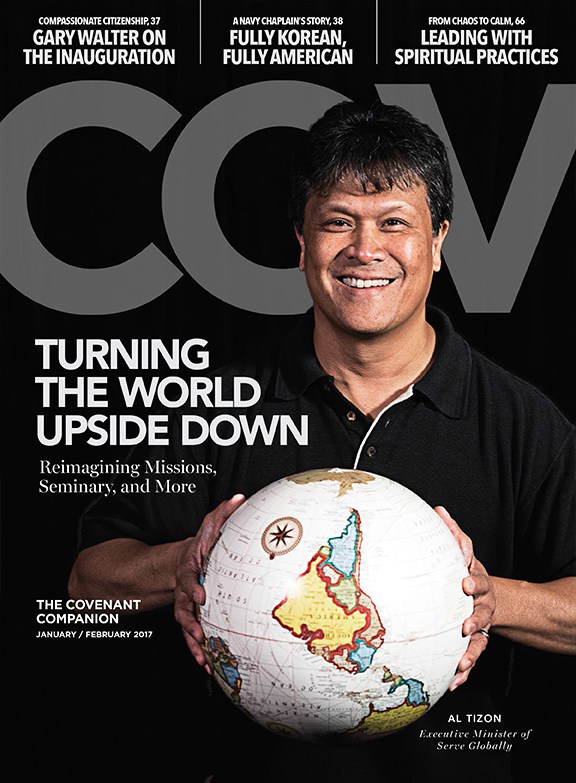
Comments